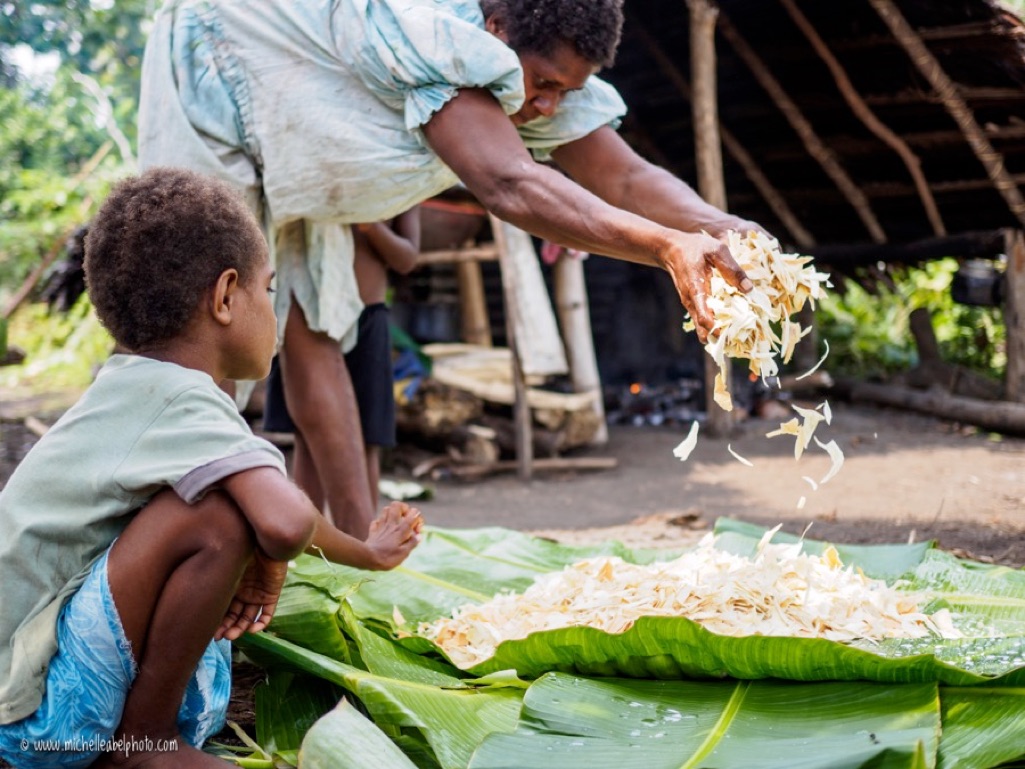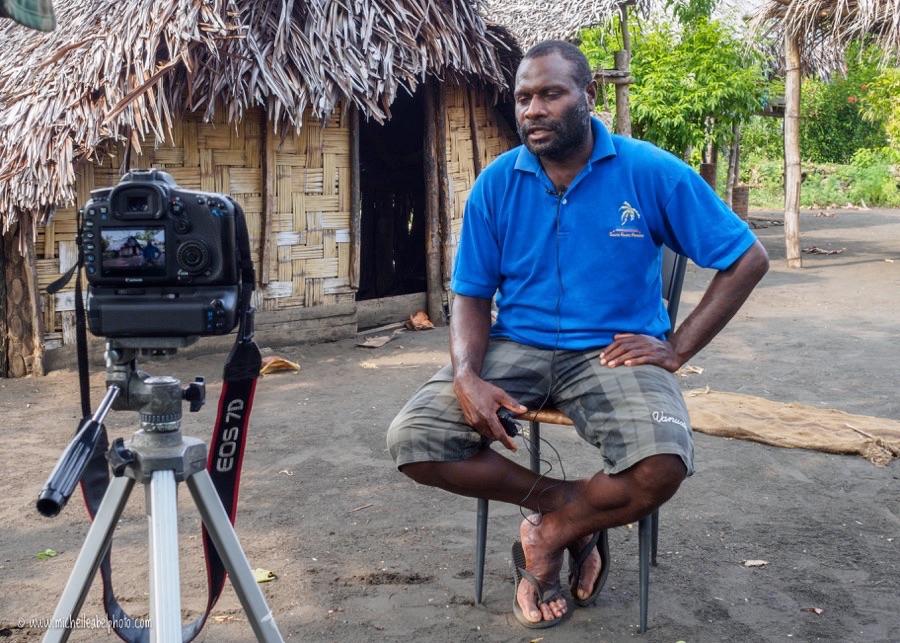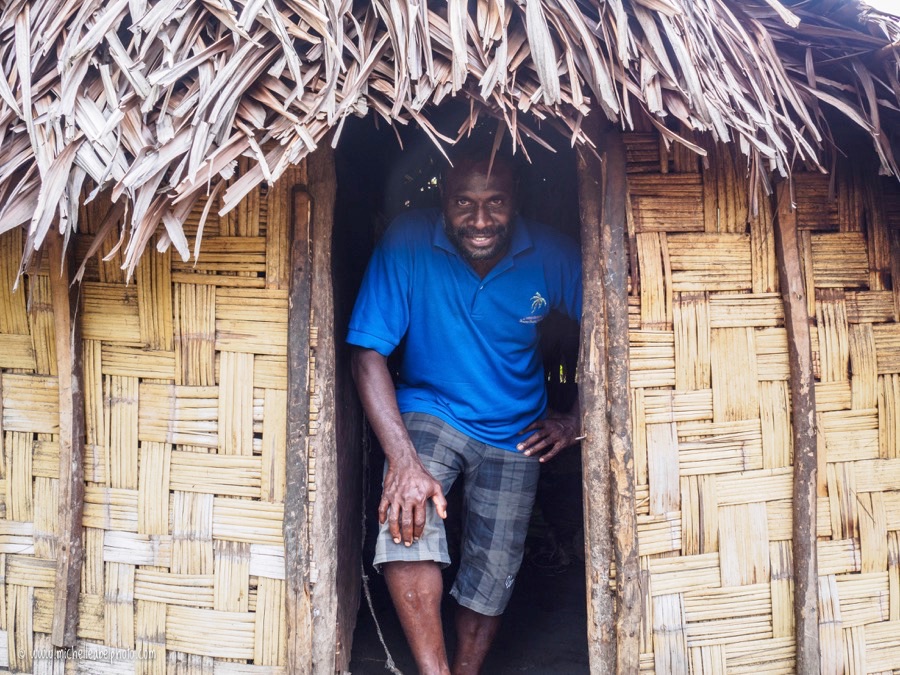Vanuatu: One Year Later
10 March, 2016
 The village is peaceful, washing drying in the afternoon sun. It’s too hot to do anything much other than find a place in the shade, hopefully with a breeze. John Andre is sitting on a chair outside his kitchen. He looks a little uncomfortable, as he has a lapel mike attached to his shirt. He is facing a camera on a tripod, the cameraman, an ADRA trainer, myself and three guys who came along with us in the truck. I am traveling with an ADRA team around South East Ambrym Island in Vanuatu. It’s been almost a year since Cyclone Pam, the strongest cyclone in Vanuatu’s history, devastated many communities here. South East Ambrym was one of the locations that ADRA worked with in the weeks after the disaster. My role here today is to talk to community members about their experiences in Cyclone Pam, and their perceptions of how ADRA worked with them after Cyclone Pam. In this village I am not doing any interviews or facilitating any meetings. We are here because of a story that we were told down at the beach when asking around for good people to interview on camera. As I am not on duty I am taking atmospheric shots of red hibiscus nodding in the sun, faded dresses gently blowing on the line. I can understand about 80% of Bislama (one of the main languages in Vanuatu), so I am only partly paying attention to John as he starts to tell his story, but soon I am standing alongside the cameraman, riveted as he talks into the camera. He doesn’t need any prompting. There are no stops and starts or embarrassing mumbles. He speaks quickly and directly about that night of 13 March 2015. He had heard warnings of a cyclone over the local radio early in the day. During the afternoon all radio broadcasts went silent. As the winds started to build he gathered his family close and they discussed where to shelter. Each village should identify a place for evacuation during a cyclone. Many villages chose their church or school. John’s village didn’t have any strong permanent buildings like that. He decided that their kitchen would have to do. It is built low to the ground, with natural woven walls, and a thick thatched roof. He gathered his family inside and closed the door. As the winds grew stronger John was concerned about other families in his community, so he went outside and went from house to house to check if everyone was feeling safe. Many families were terrified, so John suggested they join his family. In every village there are strong cultural obligations about not being too close to certain relatives, or even looking them in the eye. As more and more people came into his kitchen John told them that there was a time for “tambu kastom” but during a cyclone respecting traditions were not possible. They all had to shelter together. Eventually John had 72 people inside his kitchen! Huddled in so close they could barely move, they clung to each other as the 350 kilometre per hour winds howled around them, blowing their homes apart, striping the trees of leaves and branches, and destroying their gardens.
The village is peaceful, washing drying in the afternoon sun. It’s too hot to do anything much other than find a place in the shade, hopefully with a breeze. John Andre is sitting on a chair outside his kitchen. He looks a little uncomfortable, as he has a lapel mike attached to his shirt. He is facing a camera on a tripod, the cameraman, an ADRA trainer, myself and three guys who came along with us in the truck. I am traveling with an ADRA team around South East Ambrym Island in Vanuatu. It’s been almost a year since Cyclone Pam, the strongest cyclone in Vanuatu’s history, devastated many communities here. South East Ambrym was one of the locations that ADRA worked with in the weeks after the disaster. My role here today is to talk to community members about their experiences in Cyclone Pam, and their perceptions of how ADRA worked with them after Cyclone Pam. In this village I am not doing any interviews or facilitating any meetings. We are here because of a story that we were told down at the beach when asking around for good people to interview on camera. As I am not on duty I am taking atmospheric shots of red hibiscus nodding in the sun, faded dresses gently blowing on the line. I can understand about 80% of Bislama (one of the main languages in Vanuatu), so I am only partly paying attention to John as he starts to tell his story, but soon I am standing alongside the cameraman, riveted as he talks into the camera. He doesn’t need any prompting. There are no stops and starts or embarrassing mumbles. He speaks quickly and directly about that night of 13 March 2015. He had heard warnings of a cyclone over the local radio early in the day. During the afternoon all radio broadcasts went silent. As the winds started to build he gathered his family close and they discussed where to shelter. Each village should identify a place for evacuation during a cyclone. Many villages chose their church or school. John’s village didn’t have any strong permanent buildings like that. He decided that their kitchen would have to do. It is built low to the ground, with natural woven walls, and a thick thatched roof. He gathered his family inside and closed the door. As the winds grew stronger John was concerned about other families in his community, so he went outside and went from house to house to check if everyone was feeling safe. Many families were terrified, so John suggested they join his family. In every village there are strong cultural obligations about not being too close to certain relatives, or even looking them in the eye. As more and more people came into his kitchen John told them that there was a time for “tambu kastom” but during a cyclone respecting traditions were not possible. They all had to shelter together. Eventually John had 72 people inside his kitchen! Huddled in so close they could barely move, they clung to each other as the 350 kilometre per hour winds howled around them, blowing their homes apart, striping the trees of leaves and branches, and destroying their gardens.  They all stayed inside until morning, when the winds dropped. John lead them all in a prayer of thanks that they survived the night, then he decided to go outside and see if he could find any food. He had been thinking about his cow all night. He knew that the cow would give them all something to eat until hopefully help arrived from the National Disaster office, but he would hate to have to kill the cow himself. As he made his way through the debris he saw that his cow had been killed by a falling coconut palm, so he breathed a prayer of thanks (he joked to the camera that “God killed the cow for me!”) and together the 72 people sheltering in his kitchen were able to make a fire and eat the beef with scavenged vegetables that had been ready to harvest when the cyclone hit. I asked him how long it was before they received any outside help. John thought to himself for a few minutes to be sure, revisiting memories of a time so hard for his community that I can barely imagine it. “It was ADRA,” he said, “ADRA was the first organisation that came to help us.” Cyclone Pam destroyed Vanuatu’s mobile communications infrastructure. For two weeks after the cyclone many communities had no contact with the outside world. They didn’t know the extent of the cyclone’s damage, they didn’t know if the capital Port Vila survived. They didn’t know if any help was coming at all. ADRA was able to reach South East Ambrym with a shipment of food aid, household water filtration kits, hygiene kits, and tools for reconstruction three weeks after Cyclone Pam. Over the next two months ADRA helped with two more distributions of food aid while communities like John’s were waiting for the first harvest from their restored gardens. The food aid was just enough – a mother in the community tells me that when their first crops were ready they still had a little rice left from the ADRA food packages. John’s kitchen has now become a local legend. They still use it as a kitchen, and when I stick my head inside and squint through the dusty gloom I try to imagine 72 people shivering in front of me, unsure if in the next minute the wildest winds of their lifetime would blow them to the volcano crater in the centre of Ambrym. Today the kitchen is as it should be, with pots and pans sitting quietly in their place in a dirt yard swept spotless. The village has been replanted with flowering plants that are now in bloom, and many of the smaller trees have leaves again. It will take longer for the bigger trees to return. Almost 12 months after Cyclone Pam many homes still have tarpaulins distributed by ADRA spread over the damaged thatched roofs, because the traditional material they used for thatch grows on a type of tree that was mostly destroyed during the cyclone, and it will take another year or two before they can harvest the leaves to repair the thatch on most buildings in the village.
They all stayed inside until morning, when the winds dropped. John lead them all in a prayer of thanks that they survived the night, then he decided to go outside and see if he could find any food. He had been thinking about his cow all night. He knew that the cow would give them all something to eat until hopefully help arrived from the National Disaster office, but he would hate to have to kill the cow himself. As he made his way through the debris he saw that his cow had been killed by a falling coconut palm, so he breathed a prayer of thanks (he joked to the camera that “God killed the cow for me!”) and together the 72 people sheltering in his kitchen were able to make a fire and eat the beef with scavenged vegetables that had been ready to harvest when the cyclone hit. I asked him how long it was before they received any outside help. John thought to himself for a few minutes to be sure, revisiting memories of a time so hard for his community that I can barely imagine it. “It was ADRA,” he said, “ADRA was the first organisation that came to help us.” Cyclone Pam destroyed Vanuatu’s mobile communications infrastructure. For two weeks after the cyclone many communities had no contact with the outside world. They didn’t know the extent of the cyclone’s damage, they didn’t know if the capital Port Vila survived. They didn’t know if any help was coming at all. ADRA was able to reach South East Ambrym with a shipment of food aid, household water filtration kits, hygiene kits, and tools for reconstruction three weeks after Cyclone Pam. Over the next two months ADRA helped with two more distributions of food aid while communities like John’s were waiting for the first harvest from their restored gardens. The food aid was just enough – a mother in the community tells me that when their first crops were ready they still had a little rice left from the ADRA food packages. John’s kitchen has now become a local legend. They still use it as a kitchen, and when I stick my head inside and squint through the dusty gloom I try to imagine 72 people shivering in front of me, unsure if in the next minute the wildest winds of their lifetime would blow them to the volcano crater in the centre of Ambrym. Today the kitchen is as it should be, with pots and pans sitting quietly in their place in a dirt yard swept spotless. The village has been replanted with flowering plants that are now in bloom, and many of the smaller trees have leaves again. It will take longer for the bigger trees to return. Almost 12 months after Cyclone Pam many homes still have tarpaulins distributed by ADRA spread over the damaged thatched roofs, because the traditional material they used for thatch grows on a type of tree that was mostly destroyed during the cyclone, and it will take another year or two before they can harvest the leaves to repair the thatch on most buildings in the village.  After we get some photos of John in the doorway of his kitchen I wander over to watch a mother and daughter prepare “sepsep” – which is a huge pile of finely sliced sweet potato mixed with coconut cream and grated coconut, wrapped in green banana leaves and cooked on hot stones. Everyone says they are ok for food now, but nature has handed them another challenge with the current El Nino weather system, so their gardens are struggling in the increased heat and lack of rain. With the destruction of the upper-story of vegetation by the cyclone the gardens are facing more direct sunshine, and here El Nino means the sun is hot. Soon ADRA will be working with the communities on a permanent water system, and the construction of good toilets. If funding can be found there is opportunity to work with these communities on helping them change their gardening practices to cope better with hotter and dryer growing conditions. There is also the challenge of income generation, as almost every family I speak with made their cash income from harvesting copra from coconuts, but since the cyclone the coconuts have been dry shells. They think it will take a few more years before they are able to generate sufficient income from copra again, and in the meantime children miss out on health care or drop out of high school because there is no cash to pay fees. I am told over and over again how thankful families are for the help that ADRA was able to provide, help that came from many people in Australia and New Zealand. Families here have hope, and are working hard to secure their future, but they face many challenges. As I leave the leaders of the community disaster committees are gathering to attend a hazard mapping exercise run by the National Disaster Office. The hazard they are talking about this time? The rumbling volcano in the centre of Ambrym Island, the source of the dark rich fertile soil here, and a magnet for tourists to the island who want to photograph the lava lakes in the craters. Hope, opportunities and challenges. As we leave children dance alongside the car, calling out goodbye. ~ ~ ~ Michelle Abel visited Vanuatu in February to conduct a review of ADRA’s response following Cyclone Pam in March 2015. These are her photos.
After we get some photos of John in the doorway of his kitchen I wander over to watch a mother and daughter prepare “sepsep” – which is a huge pile of finely sliced sweet potato mixed with coconut cream and grated coconut, wrapped in green banana leaves and cooked on hot stones. Everyone says they are ok for food now, but nature has handed them another challenge with the current El Nino weather system, so their gardens are struggling in the increased heat and lack of rain. With the destruction of the upper-story of vegetation by the cyclone the gardens are facing more direct sunshine, and here El Nino means the sun is hot. Soon ADRA will be working with the communities on a permanent water system, and the construction of good toilets. If funding can be found there is opportunity to work with these communities on helping them change their gardening practices to cope better with hotter and dryer growing conditions. There is also the challenge of income generation, as almost every family I speak with made their cash income from harvesting copra from coconuts, but since the cyclone the coconuts have been dry shells. They think it will take a few more years before they are able to generate sufficient income from copra again, and in the meantime children miss out on health care or drop out of high school because there is no cash to pay fees. I am told over and over again how thankful families are for the help that ADRA was able to provide, help that came from many people in Australia and New Zealand. Families here have hope, and are working hard to secure their future, but they face many challenges. As I leave the leaders of the community disaster committees are gathering to attend a hazard mapping exercise run by the National Disaster Office. The hazard they are talking about this time? The rumbling volcano in the centre of Ambrym Island, the source of the dark rich fertile soil here, and a magnet for tourists to the island who want to photograph the lava lakes in the craters. Hope, opportunities and challenges. As we leave children dance alongside the car, calling out goodbye. ~ ~ ~ Michelle Abel visited Vanuatu in February to conduct a review of ADRA’s response following Cyclone Pam in March 2015. These are her photos.
 1800
242 372
1800
242 372